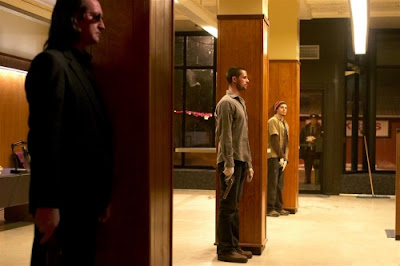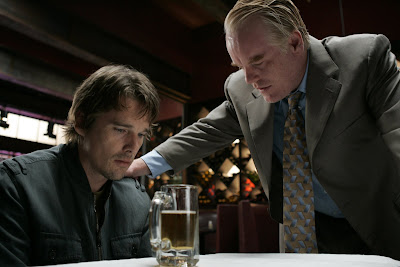
With every film, each one more of a lazy trifle than the last, Chabrol makes it easy to forget that he was once the surviving member of the French New Wave with the most wickedly comical wit, his string of thrillers puncturing the duplicitous posturing of the bourgeoisie. His latest is a pale shadow of what his work once was. His portraits of upper-class Parisian society are as empty as the characters that inhabit his films. The titular “girl” (the title is explained in the film’s conclusion with a literal-mindedness which is jaw-dropping) is Gabrielle De Neige (Ludivine Sagnier), a TV weather woman divided, as per the films title, between the affection of the much older novelist Charles Saint-Denis (François Berléand) and the foppish, arrogant pharmaceutical heir Paul Gaudens (Benoît Magimel), the latter of whom pursues her with an obsessiveness that can only be called stalking. All the characters go through their mechanical motions with what passes as wit nowadays in Chabrol’s films. At the end, this concoction is far less than the sum of its parts.
Silent Light (Carlos Reygadas)

Bracketed by stunning, surreally beautiful shots of a sunrise and a sunset, Reygadas’ new film, set among the Mennonite community of Chihuahua, Mexico, contains passages of similar uncommon beauty to the opening and closing shots. Reygadas’ two previous films, Japón and Battle in Heaven, also proved his prodigious command of composition, but his gifts were married to much more provocative subject matter than can be found here. This is both a good and a bad thing. Good, because Reygadas finds exquisite visual poetry in a beam of light, shadow play on grass, and a man’s impromptu dance to a pop song; bad, because the material can seem so gossamer-thin as to nearly disintegrate. My first reaction to the film was disappointment that it seemed to lack the revelatory power of his previous films, but the more I think about the film, the more I suspect a second viewing may be in order. Filmed with an unsettling serenity, Silent Light sets a lulling mood that is violently broken a few times: for a central sex scene and two passages of copious weeping. Cast with Mennonite non-actors, some from the film’s northern Mexico setting, others from as far away as Canada and Kazakhstan, the story is exceedingly simple. Johan (Cornelio Wall Fehr) deeply loves his wife Esther (Miriam Toews), yet carries on an affair with Marianne (Maria Pankratz), which in this community is a nearly unthinkable transgression. However, the film focuses less on the taboo-breaking nature of this relationship than on the daily tasks of tending farm and other work which is often mesmerizing to watch. Appropriately for the religious community where this story is set, the film culminates in a miraculous event, which recalls Dreyer’s Ordet. The impact of this is lessened by the fact that the viewer is kept at such an arms-length, observatory distance that in the end one can greatly admire this film, but not quite love it.
Go Go Tales (Abel Ferrara)

Opening to the exuberant strains of Archie Bell and the Drells’ “Tighten Up,” Ferrara’s strip-club fantasia can be said to be a lighter version of Cassavetes’ The Killing of a Chinese Bookie as directed by Robert Altman. Taking place over a couple of nights, Ferrara’s film traffics in nostalgia for the seedier New York of the recent past. Adding to the fantasy feel is the patently inauthentic New York set, built on the Cinecitta Studios lot. The restless camera (courtesy of cinematographer Fabio Cianchetti, brilliantly capturing the shadowy blue neon and harsh spotlights of the interiors) becomes its own character, voyeuristically observing the frenetic activity. On this particular night poor Ray Ruby (Willem Dafoe), proprietor of gentleman’s club Ray Ruby’s Paradise, can’t catch a break. He spends the night avoiding his landlady (Sylvia Miles, shrill and hilarious), who threatens to shut down the place and sell it to a Bed, Bath, and Beyond; his strippers are on the verge of striking because of his failure to pay them; and his foolproof scheme to beat the lottery is defeated when he loses his winning ticket. Despite all this he harbors grand dreams, and his fatherly generosity extends to his dancers, for whom he becomes for one night a week the Ed Sullivan of go-go joints, closing down the club to put on a showcase for the girls’ talents to help them achieve their own dreams to leave the stripper life. Willem Dafoe delivers one of his most charming and funny performances as the doggedly (and often foolishly) optimistic Ray Ruby. Ferrara is as generous a director as Ray Ruby’s character (who is also a director in a sense, and who can be read as a stand-in for his creator), investing his film with a lively improvisational air and giving us extremely colorful characters and incident. Well worth the price of admission (surely less than the funny money supplied by Ray Ruby’s club) is Asia Argento’s strip routine, co-starring a rottweiler.
Redacted (Brian De Palma)

Or, Casualties of War II. Containing performances that rarely rise above the level of a high-school play, De Palma’s Iraq war film, despite its impeccably liberal credentials, manages to have nothing to say about the conflict, and is a collection of audience-baiting gimmicks rather than an actual film. Slightly better than the embarrassing mess that was his last film, The Black Dahlia, Redacted nevertheless is a histrionic creation as full of hot air as the apologists and war cheerleaders it is against. Inspired by the actual rape and murder of a 14 year old girl and the murder of her family by American soldiers in 2006, the film uses this potent material to pull off the sort of stunt one would expect from some young hotshot fresh out of film school, eager to show off his shiny, digital toys, rather than by someone who was once a great filmmaker. Constructed from fake found footage – a soldier’s video diary, You Tube-type footage of strident antiwar video bloggers and terrorist recordings, a French documentary – Redacted is little more than old wine in a not so new bottle. The film recently caused some minor controversy when De Palma publicly clashed with his film’s distributor, Magnolia Films, for “redacting” his photo montage of actual Iraq war casualties that concludes the film. Magnolia’s justification that this is to avoid potential lawsuits is admittedly weakly argued and an overreaction. But De Palma’s eagerness to puff his chest with self-important outrage and repeatedly state, clearly relishing the irony, “My film Redacted was redacted,” is to me equally distasteful. Exploiting dead and wounded Iraqis to lend your film a power and sense of tragedy that you have utterly failed to do on your own is hardly a principled stance. For true insight on what went wrong in Iraq and why, I suggest skipping this nonsense and instead seeing Charles Ferguson’s meticulous, brilliant documentary No End in Sight (out on DVD today).












